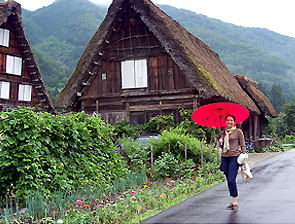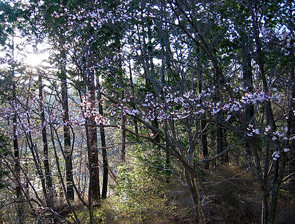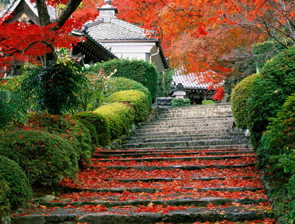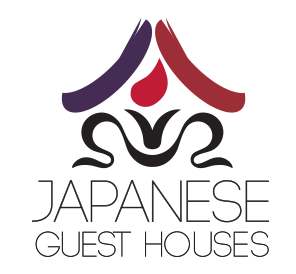Hot springs have a very long history in Japan, and they are an intimate part of Japanese culture. There are over 3,000 "onsen" ,or hot springs, in Japan. Many can be found at the ryokans available on Japanese Guest Houses.
Popular Destinations
Kyushu
Hokkaido
Kansai
Tohoku
Shikoku



Check-in time is usually from 15:00 (3:00pm) to 18:00. If you are having dinner please make sure to check in before 17:30 (5:30 pm). If you check-in after this time there is a very good chance that the ryokan will not be able to serve you dinner. However, you will be charged for dinner. The reason is the ryokans serve fresh, seasonal food to their guests. If the dinner is already prepared but sits there for several hours there is a good chance the dinner will be spoiled (and in the hot and humid Japanese summer it can be quite dangerous to serve food which has been sitting for a few hours). As a result, the ryokans serve dinner as soon as it is cooked and no later. Again, please be sure to check-in before 17:30 (5:30 pm). If you check-in early, you may also leave your luggage at the ryokan and go sightseeing before returning for dinner. Check-out time is usually before 10:00 am.
Many ryokan inns are small family-run businesses with small but busy staff. Giving them your arrival time will ensure that someone is at the front desk waiting to greet you. It is also important to let them know how you will travel to the ryokan either by train, bus, or possible car. Keep in mind that not all ryokan inns have parking and they may charge for parking.
If you are staying in a ryokan on your first night in Japan then we highly recommend not having dinner that first evening at your ryokan. After a long flight, you might not be able to fully enjoy a multi-course kaiseki meal. You would be better off waiting a day to get over jet lag first. Once you recover from the flight then you will be in a better position to fully enjoy some amazing Japanese food at your ryokan.
When entering a ryokan you must take your shoes off and then directly step up into the ryokan. Entering a ryokan with your shoes on or stepping or standing in the entryway where your shoes are is considered very dirty and rude. You would never go barefoot in a gas station bathroom so you must also never wear shoes in the ryokan.
Please, do not make last-minute changes, and if you do accept that the changes might not be possible. During your stay, ryokans in general cannot make any changes to your meals or where you are dining. For example, if you suddenly decide you do not want breakfast or if you want fish instead of meat the ryokans will generally not be able to make these changes. Please tell us while you are making your reservation if you have any special meal requests or if you wish to have meals in your room or with another group of guests. Ryokans are often small, family-run businesses, and they are simply not equipped to quickly cater to any last minute meal or dining changes.
Most of the staff at the ryokans we represent do not speak English. However, most are experienced in dealing with foreign guests and they will try their best to communicate with you during your stay (hand gestures and other body language goes a long way, believe me!). Please do not be discouraged by a lack of English language communication. In fact, we truly believe this kind of communication is a genuine and important part of your contact with Japanese culture. In addition, we provide the ryokans with a translated list of “ryokan rules” (written in English and Japanese) which they will give to you upon arrival. This list should answer any of your questions about your stay at the ryokan. Learning some basic greetings and polite phrases and polite phrases is a good idea and will make you feel more connected to Japan. If there is an emergency and you cannot make yourself understood to the staff, we will also provide an emergency phone number which you can use to call us directly.
Japanese bathtubs are for soaking, not washing yourself. First go to the washing area along the walls with small stools, mirrors, wash buckets, soap, and shampoo. Once you are clean then completely rinse off all of the soap and shampoo. Now you can walk to the bath tube and get in. The bathwater is not changed for each bather so please keep the water as clean as possible. Japanese baths are one of the best things about staying at a ryokan. A more detailed explanation about bathing in Japan is here.
Kaiseki (traditional, multi-course Japanese dinner) – This is usually a 6 to 15-course dinner beginning with appetizers. The appetizers are followed by “sashimi” or sliced, raw fish (dip the seafood in the dish of soy sauce and season it with wasabi). Next is a clear soup, grilled meat or fish, steamed vegetables, a hot-pot, and a salad with dressing. Rice, miso soup, and Japanese pickles (tsukemono) are served at the end of the meal, and fruit or jelly is served for dessert. For more info, please see Japanese kaiseki.
Country-style Dinner – Country-style meals are often centered around whole grilled river fish; “sashimi” or raw seafood; fresh vegetables served boiled or as tempura; vegetable soup; pork, beef, chicken, or even wild boar hot-pots.
Japanese Breakfast – A typical Japanese-style breakfast is rice, miso soup, grilled fish, and Japanese pickles (tsukemono). Breakfast also comes with “nori” or dried sea vegetables to eat with your rice (lay a sheet of nori on your rice and bring the ends together with your chopsticks to trap the rice inside). A small, salty plum (umeboshi) is sometimes served as well as “natto” or sticky fermented soybeans and a raw egg (crack the egg into a small bowl; add a dash of soy sauce and beat it with your chopsticks; pour it over your rice). Some ryokans serve their own special breakfasts featuring local delicacies. Some ryokans also offer Western breakfasts though these must be requested when making your reservation.
“Osechi” (New Year’s Food) – During New Year’s you may be served Japanese “osechi” during your stay. Osechi had its earliest origins in a year-end ceremony introduced to the Imperial Court from China during the Nara Period (710-793). Today it is a tradition to eat osechi during “Oshogatsu” which is the first 3 days of the New Year. The food is prepared before New Year’s Eve, and they are stored in a refrigerator during the three day holiday period. The food is packed into 3 or 4 layers of lacquered boxes called “jubako.” Osechi represents happiness, good health, and a bountiful harvest. The different kinds of osechi dishes have special meaning too. For example, “tai” (sea bream) symbolizes a happy or important occasion; “kazunoko” (herring roe) represents having many children, and so on.
Many ryokans take tremendous pride in serving their guests the best of the local cuisine in the area. In the Takayama or Gero Onsen areas, for example, expect a meal of Hida beef, river trout, and freshly-picked mountain vegetables. Along the seacoast, guests will usually dine on freshly-caught fish and other seafood delights. Meals are served either in the privacy of your room or in a large dining area. Alcoholic beverages such as beer or Japanese sake (really good!) are not included with your dinner and must be ordered separately. Tipping is not necessary but if you want to leave a tip, put 1,000 yen in a small envelope or wrap it with white paper and give it to the maid when your final dinner is served. If dinner is being served in your room, the ryokan staff will set up everything on the low table in your room. Dinner time is usually around 18:00.
Hyogo-ken Chijitoroku Ryokogyo 3-609
(Hyogo Prefecture Travel Agent License Number 3-609)
10-5-401-1-(2) Sakae-machi, Kawanishi-shi, Hyogo-ken Japan
Part of the Rediscover Group of Travel Companies Rediscover Japan Co., Ltd. (Japanese Guest Houses)
Website Design & Marketing by: Douglas Marketing Group

